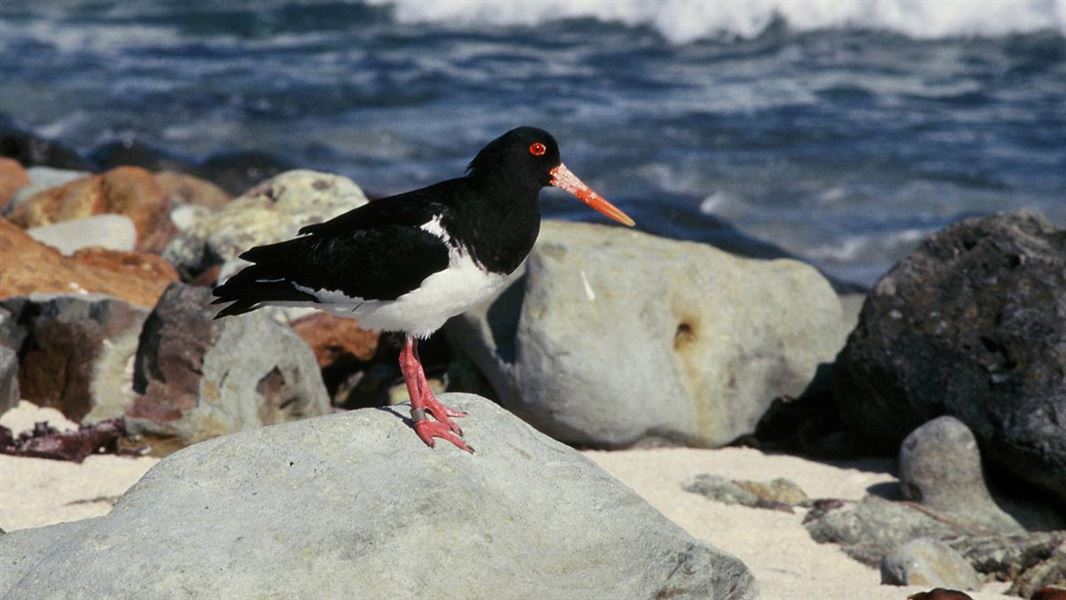
Introduction
This black and white wader is unique to the Chatham Islands. It is an endangered species with a high risk of extinction due to its very small population and rangeNew Zealand status: Endemic
Conservation status: Threatened–Nationally Critical
Found in: South East Island, Pitt Island, Mangere Island, and Chatham Island
Threats: Predation, human disturbance, habitat loss
Sound recording:
Chatham Island oystercatcher/tōrea song (MP3, 3,077K)
03:16 – Chatham Island oystercatcher/tōrea song.
Species information: Chatham Island oystercatcher on NZ Birds Online
Chatham Island oystercatcher conservation
Emergency hotline
Call 0800 DOC HOT (0800 362 468) immediately if you see anyone catching, harming or killing native wildlife.
Thanks to the efforts of an intensive management progamme, bird numbers have increased and the future outlook for the species looks quietly optimistic.
In December 2004 the oystercatcher population included 88 breeding pairs and a total of 311 birds. This is more than double the number of birds counted in 1998 at the start of the management programme.
Early conservation efforts
Past oystercatcher management has been piecemeal.
Conservation in the early 1990s focussed on predator trapping, and fencing to limit stock access to nesting areas. Some nests were moved away from the high tide mark. Nest manipulation may have helped to increase hatching success. Artificial incubation was also attempted, but did not increase overall productivity.
Intensive management programme
An intensive Chatham Island oystercatcher management programme began in 1998.
Predator control
Predation of eggs and chicks by cats, hedgehogs and weka has a major impact on species productivity and has been the most significant cause of population decline.
Predator control in the plan was to protect the 16 oystercatcher territories on northern Chatham Island. It also included modification of fences to exclude stock from managed areas.
Nest relocation and dune restoration
Introduced marram grass has formed dense swards along much of the coast and artificially steepened the sand dunes, leaving few open areas the oystercatchers prefer to nest in. This forces the oystercatchers to nest close to the high-tide line where tides and storm waves can wash away nests.
The plan involved moving of nests away from the high tide mark, and restoring dunes to provide more habitat.
Video monitoring
Nests were monitored with video cameras. Some of this footage was even packaged for Chatham Island television, giving helpful publicity to the conservation effort.
Joint management and research programme
In 1999 a joint management/research programme commenced. So far this programme has been very successful, and includes the following outcomes:
- New breeding pairs have been established.
- A significant number of chicks has been produced.
- Many chicks have been colour banded to aid future monitoring.
- Research involving the monitoring of breeding success, nest losses, and bird movements, has been 'more successful then originally anticipated.'
Recovery plan
The long-term vision of the Chatham Island Oystercatcher Recovery Plan is to:
'Restore the natural ecology of the coast so that the oystercatcher population is maintained at or above 250 birds with minimal management.'
Chatham Island oystercatcher recovery plan 2001–2011 (PDF, 163K)
You can help
Oystercatchers depend on the coast for their food and for a safe place to rear their young. Nesting birds are easily disturbed by people and will move from the nest to draw you away. Birds with chicks are often noisy and may swoop.
- If birds appear to be disturbed by your presence, move further along the beach.
- Walk or drive below the high tide mark to avoid crushing eggs or chicks.
If you are travelling to the Chatham Islands, or transporting goods or livestock there, be careful that you don't introduce pest animals and plants or diseases. These could threaten the flora and fauna in this unique environment.